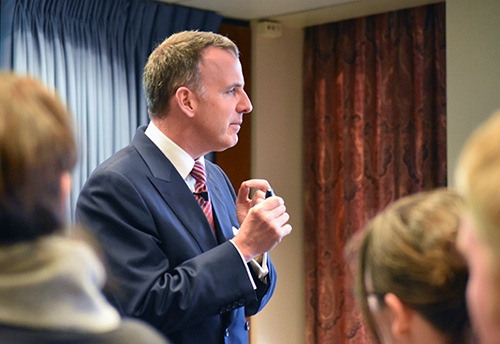Exploring the Interplay Between Cities and Transportation
Cities are built on transportation.
The sites for America’s older, colder cities—like New York and Boston—were attractive because they were positioned on natural harbors. As the country expanded west, canals and rail networks allowed cities like Chicago to blossom. And when the nation turned its transportation eye toward vehicles powered by internal combustion engines, cities like Houston grew up.
Today as much as ever, transportation is shaping America’s cities.
“We’re certainly in an era in which technology is changing quickly and has the capacity to change cities quickly as well,” said Harvard University economics professor Edward Glaeser, who spoke as part of Volpe’s Future of Transportation series. “I think that could be a very good thing if it’s done well, and it could be a very unwise thing if done poorly.”
From Waterways to Highways
The urban system came about to solve a transportation problem: how to move goods and people across a vast country. In 1900, the 20 largest cities in America were located on a major waterway, Glaeser said.
“We know that in 1816, it cost about as much to ship goods 30 miles over land as it did to ship them across the entire Atlantic Ocean, which is why we’ve clung to our Atlantic lifeline,” Glaeser said.
As America fell in love with the automobile in the 1900s, the automobile also became the means by which to ship things inexpensively. During the 1900s, the cost of moving a ton of goods one mile dropped roughly 90 percent, Glaeser said. This dramatic decline in shipping costs set the backdrop for factories and people to move from cities that had an advantage in old transportation modes—water and rail—to those constructed to move goods and people by vehicle.
“We reshaped whole cities around the car,” Glaeser said. “That’s how I see the great suburbanization of America: It’s a moving of people to areas in which they can get around by car rather than walking.”
Watch video highlights of Edward Glaeser's talk at Volpe.
Technology Needs Policy
The apocryphal story of the Croton Aqueduct goes like this: New York City’s burgeoning population was being ravaged by disease and infant mortality, and the culprit was a lack of clean water. The Croton Aqueduct in 1842 brought fresh, clean water from Westchester County to the city and provided the stability in basic health that let New York flourish over the following decades.
The catch? Connecting to the aqueduct cost money, and so for New York’s poorest residents, clean water remained out of reach for years. In reality, wide-scale declines in death rates were not seen until the city mandated in the 1860s that people connect to the aqueduct system, Glaeser said.
The lesson of the Croton Aqueduct is that for a technological advance to benefit society, policies are often needed to address concurrent behavioral responses. Today’s transportation equivalent to the lesson of the Croton Aqueduct has to do with vehicle miles traveled, which increases at a roughly one-to-one ratio with each highway mile built, Glaeser said.
“I am terrified of what autonomous vehicles will do for traffic in the cities,” Glaeser said. “Unless this is coupled with something that pushes back on the behavioral response, this could well be a curse rather than a blessing.”

Edward Glaeser speaks to an audience at Volpe as part of the Future of Transportation series. (Volpe photo)
American Dreams Beyond the White Picket Fence
Each city has angels and demons. Cities are cauldrons of new ideas and innovation, but they do not work for everyone. There is a line that should not be crossed between polices that address established human behavioral challenges, and policies that proscribe living in suburban areas, Glaeser said.
Transportation policy instead should aim toward mobility that makes urban and suburban dreams real:
“We should not have social engineering that acts as if the American dream can only lie behind a white picket fence in the suburbs,” Glaeser said. “Smart transportation, sensible transportation, is part of realizing a more inclusive American dream that involves all types of living.”

